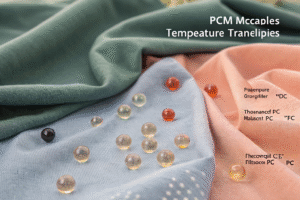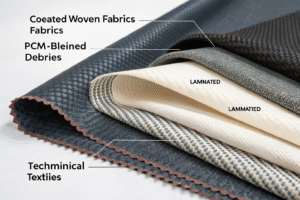Phase Change Material (PCM) fabrics are transforming the way we think about thermal regulation in textiles. Originally developed for space applications, PCM technology has made its way into sportswear, outdoor gear, bedding, and medical fabrics. But for sourcing managers, brand owners, or textile developers, one question matters most—what options are available, and which are right for your product?
PCM fabrics are available in multiple forms, including microencapsulated coatings, bicomponent yarns, and lamination-based solutions. Options vary by application, from athleticwear to aerospace textiles, each offering different phase transition temperatures, durability, and moisture control features.
In this guide, I’ll walk you through the structural differences, top-performing PCM types, and what global buyers need to consider before integrating these intelligent fabrics into their collections.
How Does Phase Change Technology Work in Textiles?
Understanding the core function of PCMs is key to choosing the right fabric structure. A phase change material absorbs or releases latent heat when it changes its physical state—from solid to liquid or vice versa—maintaining a stable microclimate around the human body.
In textile applications, PCMs are usually encapsulated in microcapsules and either embedded within fibers or applied as coatings. When the body temperature rises, the PCM absorbs heat and melts; when temperature drops, it solidifies and releases warmth back.

What Are the Most Common PCM Types in Fabric?
There are primarily two PCM categories used in textiles:
- Paraffin-based PCMs: Widely used due to their cost-effectiveness and stable transition temperature.
- Bio-based PCMs: Derived from natural oils, offering better biodegradability and sustainability.
According to Outlast Technologies, paraffin-based PCM microcapsules are still the most commercially available and scalable for use in apparel and bedding.
Where Are PCM Fabrics Typically Used?
PCM fabrics are now applied in:
- Sportswear & Outdoor Gear for regulating sweat and body heat.
- Medical Wearables for burn patients or temperature-sensitive therapies.
- Home Textiles such as smart blankets or mattress protectors.
- Military Uniforms for extreme climate readiness.
You can explore deeper applications via NASA Spinoff since PCMs were first used in space suits.
What Fabric Structures Are Compatible With PCM Integration?
The method of PCM delivery to fabric matters. Not all fabric types perform equally, especially under abrasion or repeated laundering.
PCM can be added through coatings, embedded in yarns, or applied via film lamination. The choice depends on desired breathability, stretch, end-use durability, and whether the product needs direct skin contact comfort.

How Are PCM Coatings Applied?
This is the most common method. PCMs are encapsulated and coated onto the fabric surface using:
- Pad-dry-cure coating for knits or woven bases.
- Screen printing for zone-specific thermal regulation.
- Spray and foam methods for stretchwear.
At Fumao Fabric, we partner with chemical formulators who specialize in eco-compliant PCM coatings for sportswear and uniform applications, applying them to polyester, modal, or spandex-based bases.
For in-depth methods, see ScienceDirect's textile PCM research.
Can PCM Be Added Directly to Yarn?
Yes, via bicomponent fiber spinning. PCM is blended into the core of synthetic yarns like polyester or nylon. This improves durability and wash resistance but adds cost.
Leading technology in this field includes Clariant’s Thermocules™, which embeds PCM into the polymer matrix before extrusion, resulting in long-lasting thermoregulation in performance wear.
What Are the Top Use Cases for PCM Fabrics in Apparel?
Smart textiles need smart planning. Not all PCM fabrics are equally suited for every end use. Temperature ranges, user comfort, and activity level must be matched with the right PCM structure and weight.
Top uses for PCM fabrics include temperature-adaptive sportswear, heated military base layers, smart underwear, cooling caps, and maternity wear. Each has unique performance and comfort requirements.

Why Is PCM Great for Activewear?
When we exercise, our skin temperature can fluctuate rapidly. PCM fabrics help regulate that by keeping temperature close to the optimal 33°C–35°C range. That’s why performance wear brands are adding PCMs to:
- Base layers (e.g., PCM-treated polyester jersey).
- Mid-layers (e.g., fleece with laminated PCM liners).
- Compression gear to reduce overheating.
Global brands like Under Armour have experimented with Outlast® PCM for body-heat regulation during intense workouts.
What About Casual or Medical Clothing?
For garments not focused on athletic performance, comfort and passive thermal balance are the goal. Common applications:
- Pregnancy support belts using PCM-knitted jersey.
- Sleepwear for menopause-related hot flashes.
- Hospital patient gowns to avoid temperature shock.
Studies published by Taylor & Francis Online have shown PCMs reduce discomfort and sleep disturbances due to night sweats in clinical settings.
What Are the Sourcing Considerations for PCM Fabrics?
Sourcing PCM fabrics comes with special challenges. Not every supplier can handle thermal coatings, and even fewer can guarantee durability after multiple washes or dry cycles.
Key considerations include testing standards, MOQ, coating method, licensing (Outlast® or non-branded PCM), base fabric compatibility, and sustainability credentials.

What Tests Are Important for PCM-Integrated Textiles?
You should request the following reports:
- Differential Scanning Calorimetry (DSC): to verify phase change temperature and enthalpy.
- AATCC 135: for home laundry durability.
- FTIR Spectroscopy: for coating verification.
At Fumao, we use SGS and CNAS labs to provide these certifications with each batch. We also provide QR-coded digital lab reports for traceability. Read more on SGS’s textile testing capabilities.
What’s the MOQ and Cost Range?
Depending on structure and use:
| PCM Fabric Type | MOQ | Price Range (USD/m) |
|---|---|---|
| PCM coating on woven | 800m | $3.50–$5.50 |
| PCM laminated fabric | 1000m | $4.50–$6.80 |
| PCM-embedded yarn | 1500m | $6.00–$9.50 |
Prices vary based on whether the PCM is branded (e.g., Outlast®) or non-branded. Licensed fabrics may have higher marketing appeal but also come with royalty costs. You can explore active Outlast licensing options on their official portal.
Conclusion
Phase Change Material fabrics offer an intelligent edge to brands looking for thermal regulation without bulky insulation. Whether you need base layer performance, hospital-grade comfort, or smart home textile applications, there is a PCM solution to fit your needs.
At Fumao Fabric, we provide a full range of PCM-integrated textiles, including coatings, laminated solutions, and embedded yarns, all tested and compliant with global standards. We’ve helped performance brands, healthcare buyers, and even uniform suppliers source high-quality PCM fabrics with flexible MOQs and real-time lab traceability.
Want to discover the right PCM fabric for your project? Contact our Business Director Elaine at elaine@fumaoclothing.com to start your development journey today.










